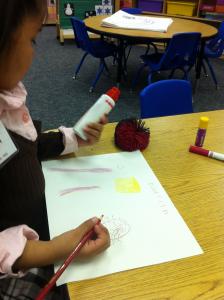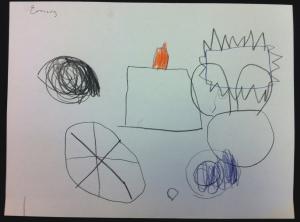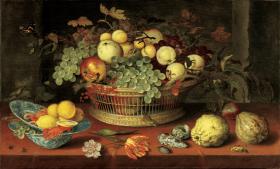Introduction / Warm-Up
- Define the word observation for students. Talk about what senses we use to observe things. Discuss Still Life with Basket of Fruit. Ask students to identify that they see and describe the tiny details they observe in the painting.
- Explain to students that this type of painting is called a still life. Ask them why it might have that name. Tell students that artists use observations to help them make a still life.
- Tell students that they are going to make their own still life artwork today. They will practice drawing objects at their tables.
- Students will use magnifying glasses to help them see even more. Explain that scientists and artists use magnifying glasses in their work to help them observe details.
- Demonstrate how to hold and use the magnifying glass. Have the students practice using the magnifying glass by looking at their hand, shoes or clothing. Have students take turns looking closely at the painting using the magnifying glass. Talk about what they can see using this tool.
- On watercolor paper cover of sketchbook demonstrate using the watercolor pencils to draw outline of objects from a still life. Tell them that we will be doing something very special on the cover of the sketchbook. Demonstrate creating a more “finished” drawing with a lot of filling in. Tell students that when their drawing is finished, we will use water to make their cover drawings into paintings! Demonstrate brushing water lightly over the cover drawing. Mention that the paper is stronger on the cover, so they can use water on it. But later, when they draw on the inside pages, they can only use pencils or colored pencils.
- Ask students to go to their tables.
Focus Activity Procedure
- Ask students to hold magnifying glass up to the still life on their table to help find details.
- Ask students to place magnifying glass/hand lens on table (teacher may elect to collect them at this point).
- Ask students to begin drawing what they see on the cover of their sketchbook. Tell students they must draw quietly and carefully so they can be good observers.
- Encourage students to look for the shapes and details of the objects they choose.
- Reassure students that it is fine if their drawing does not look just like the object they are looking at- practice will help them become good artists!
- Encourage student to fill in their drawn objects.
- While students are drawing, circulate to talk with them about what they are carefully observing. Encourage students to look for simple shapes in the objects they are drawing. For example, the cover of their sketchbook is a rectangle. Where in the still life do you see a rectangle shape?
- When students have completed the drawing, pause the class and ask the students to write their names on the cover as the artist that made that book.
- Tell them that we will now turn their drawings into paintings like the demonstration. Explain that a tiny bit of water will make the pencil turn to paint- like magic! Students can use paper towels to dab up water puddles.
- Pass out one tub of water per table with enough brushes and paper towels for each student.
- Sketchbooks should be placed on a drying rack to dry when finished.
Closing
- Clean up by placing all materials back in their containers.
- Re-visit Still Life with Basket of Fruit. Ask students to compare how their observational drawings were similar and how they were different to the painting.
- Ask students to share which object they liked to draw the most or the least. Ask them to explain why. How did the objects look different when they were viewed through the magnifying glass? Did you like drawing the objects up close (through the magnifying glass) better? Why or why not?
- Encourage students to closely observe the world around them and draw objects that they think are interesting.
- Ask students to look for art all around them at home and at school!
- Assess listening skills and ability to observe closely by asking recall questions during discussion of Still Life with Basket of Fruit.
- Observe student work in process and in completion to assess if students have used observation skills.
- Observe students’ use of magnifying glass/hand lens during lesson to determine their comfort level with using the tool and what level they are able to record what they observe.
still life
object
sketch
magnify
observe
magnifying glass/hand lens to share as group; magnifying glass/ hand lens per student
9x12 drawing paper sketchbooks with watercolor paper covers
non-toxic watercolor pencils
paintbrushes
cups for water
still life props (small objects to draw such as plastic food, legos, or anything simple, but interesting)
paper towels
Extension Activities for Teachers
- Create an oversized classroom sketchbook out of construction paper or butcher paper. During transitions or for a quick art minute, invite students to practice drawing random objects in the classroom (this could also be a “popcorn” type drawing game). Have students take turns choosing what to draw. Label the objects and display the class sketchbook in the library.
- Use the inside pages of the sketchbook and encourage students to continue practicing their observational drawing skills by sketching at center time or during times of the day.
- Take paper and pencils outside on a nice day to make observational drawings of the school.
- Make thematic sketchbooks. For example, have students create sketchbooks that relate to the literacy theme you are currently studying or a sketchbook that has pictures that start with the letter you are learning about that week.
Suggested Books for Classroom Library
Ehlert, Lois. Planting a Rainbow. Harcourt, 1988. [ISBN 978-0-15-262609-9]
Mayer, Cassie. Markets. Heinemann Library, 2007. [ISBN 978-1-40349-404-7]
McMillan, Bruce. Growing Colors. HarperCollins, 1994, 1988. [ISBN 978-0-7587-2664-3]


Exotic seashells, carefully observed insects and fruits, and rare hybrids of flowers were elements of the seventeenth-century Dutch fascination with the natural world. An extreme manifestation of this curiosity was “tulipomania,” the folly of collectors spending huge sums to acquire individual tulip bulbs such as the one that produced the striped variety in this still life. The shells are depicted with such exactitude that they can be identified as species from seas off the coasts of the East and West Indies and Africa. These and the Chinese porcelain are evidence of the extensive trading sphere of Dutch merchants.
Van der Ast specialized in paintings of such objects, admired for their verisimilitude to nature as well as for the moral associations attached to individual motifs. For example, the painter frequently followed the convention of scattering tiny creatures and spoiling fruit in pictures as reminders of the transitory nature of life. The butterfly, grasshopper, and fruit exist for only a brief span. The fading beauty of the cut flowers reinforces this idea, but like the shells, they may have offered criticism on the practice of squandering money on objects of curiosity. Interestingly, the fruits and flowers appear together although they come from different growing seasons. Like many of his contemporaries, Van der Ast would have utilized studies that he later combined in his compositions.


